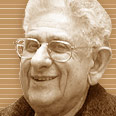
4 warning signs
Painful lessons of ancient wars still applicable today
1
Hellenist argument: Make Jerusalem a modern city. Take advantage of the permission given by Antiochus to partake in war games and contests as an entrance ticket to progress. No more primitive, inhibited and fanatic Judaism that sparks hatred and contempt in the enlightened world.
Acquire a place of honor amongst the family of nations by means of the Hellenistic culture. The gymnasium against the Temple. Integrate into the Hellenistic space to assure national existence, which is not identical to the adherence of religious laws.
So much for the Hellenists. And who are we the successors of?
2
Antiochus and his decrees were invited by Hellenistic Jews to defeat their enemies, the "Hasidim." The High Priest Menelaus incited against the "xenophobic" Jewish religion and thus paved the way to the slaughter and looting carried out by Antiochus in Jerusalem.
The Hasmonean war was largely a civil war against the Hellenists. At first Matityahu slew a Jew who sacrificed a swine at the altar. He was forced to kill the Hellenist soldiers who protected him. And then Hellenists killed, destroyed altars and circumcised children in hit and run attacks. Only repression of the Hellenists enabled Judah Maccabee to embark on the next phase of fighting the Greek army.
Crossing of lines, identifying with the enemy - such things happened in the past.
3
Only after Antiochus gave the order to destroy the people of Judah, large numbers of Maccabeans joined the army. However, when the Greeks promised to nullify the decrees, the camp dwindled once again.
The "Hasidim" abandoned the camp and opened the city and the temple to the High Priest Alkimos and to the Greek military ruler Bacchides… and they "spoke peace." Only the inevitable outcome - 60 murders in a single day - filled the ranks once more.
And they still didn't learn their lesson. When Nikanor arrived with orders of destruction but ostensibly proposed negotiations, he once again encountered high priests and elderly people in Jerusalem singing songs of peace. Only after Nikanor was exposed and threatened to burn down the Temple, did the soldiers return to the camp allowing Judah to kill Nikanor.
And again the Jews dispersed and ahead of the Battle of Elasa where Judah was killed, only 3,000 soldiers turned up.
The illusions of peace, the short sightedness, the ungratefulness - all sound too familiar.
4
It was the Sukkoth festival at the temple and with it came a new controversy - the Pharisees and Seleucids. King Alexander Yannai, a High Priest, incited the people to riot. The people pelted Alexander with etrogim (citrons) and in turn the army slew more than 6,000 people in the Temple courtyard. Until his very last moments, the King didn't see the depth of hatred amongst the people.
Blindness was apparent on both sides. The king asked the Pharisee people what would be their demands for reinstating peace and they answered: Only your death! And they proceeded to bring in the Greek-Syrian king (!)
In a battle near Nablus, where Jews in the Syrian army fought against Jews in Yannai's army, Yannai was defeated. The tables were turned when some 6,000 Jewish soldiers abandoned the Syrian army, the Syrian king fled and the Pharisees were defeated. The unbelievable then happened: The Hasmonaean king ordered the crucifixion of 800 Jewish enemy captives!
In six years of war these Pharisees and Seleucids murdered some 50,000 people.
How much darkness can we fend off!










